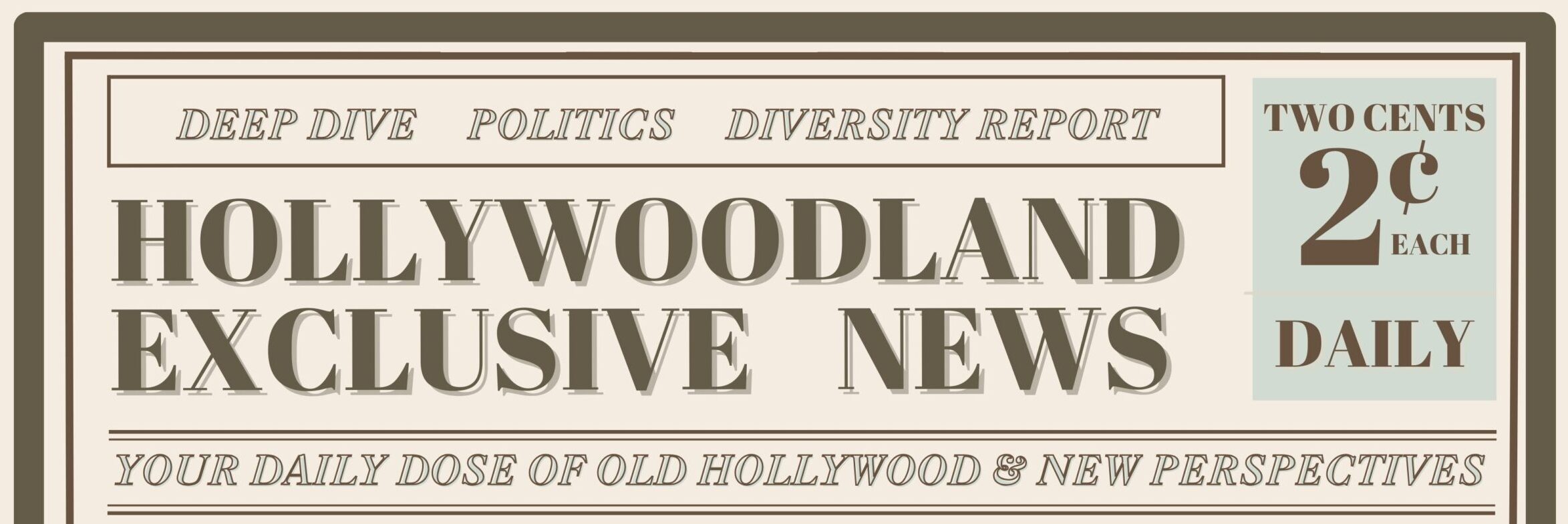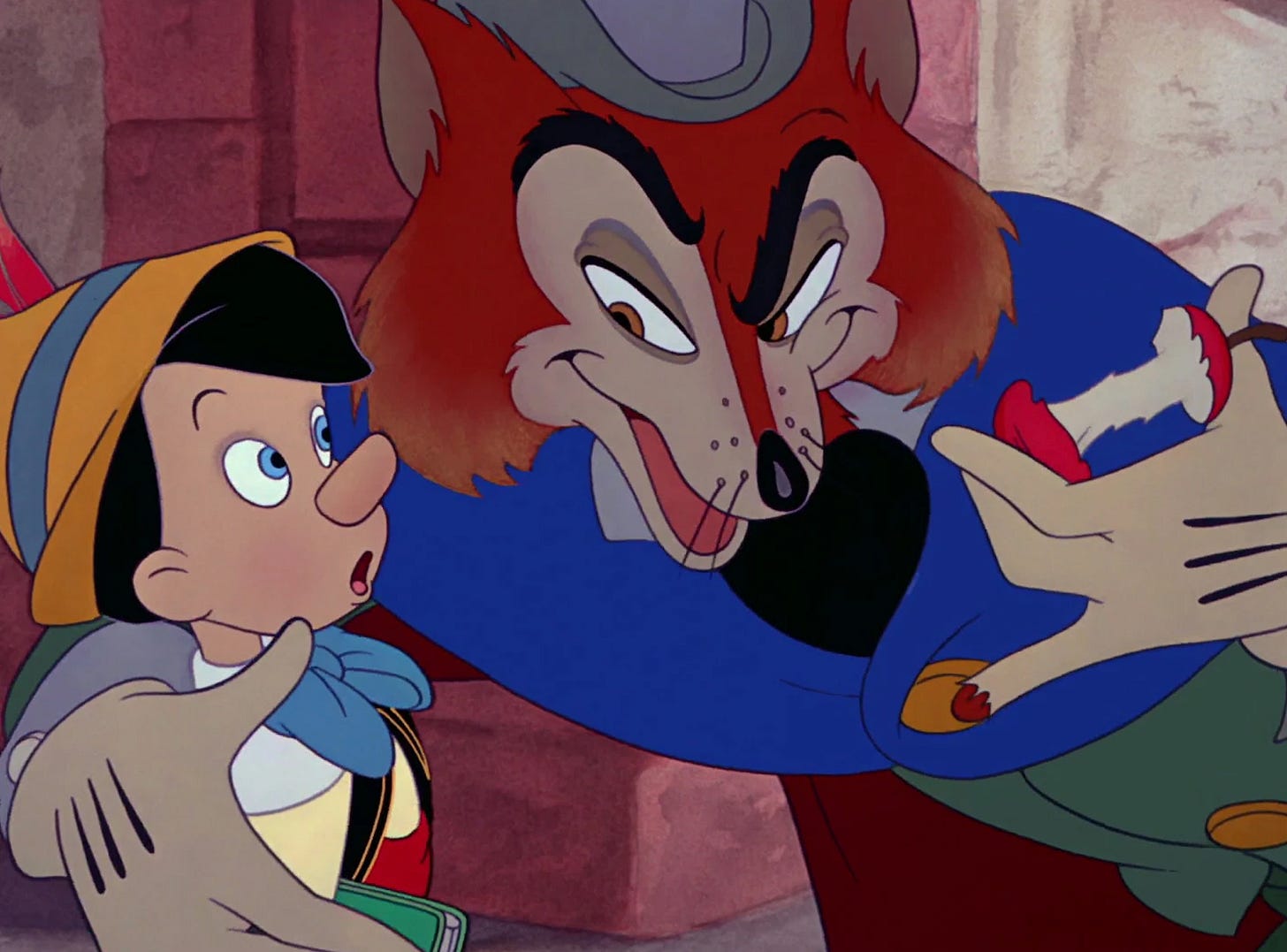
Written By
Regina Luz Jordan
Founder & Editor In Chief
When we think of Pinocchio, most of us picture Disney’s glossy 1940 version. A puppet dreams of becoming a real boy, a cricket chirps about conscience and songs like When You Wish Upon a Star sell us magic. But before Disney sugarcoated it, Pinocchio was an Italian tale written by Carlo Collodi in the 1880s, and, like most fairy tales, it was dark.
At its heart, it’s a story about grooming, exploitation, and trafficking. Disney didn’t invent it, but they did wrap it in song and sparkle, softening what was always a brutal allegory about power and vulnerability.
The Original Tale Wasn’t Wholesome
Collodi’s The Adventures of Pinocchio wasn’t bedtime comfort. It was a serialized story meant to scare kids into obedience, not tuck them in with sweet dreams. Pinocchio was defiant, reckless and constantly punished. His world wasn’t built on warmth or guidance but on harsh consequences and cruelty disguised as lessons.

But let’s be real… that was the norm. Fairy tales in the 19th century weren’t pastel colored parables. These were survival manuals. The Brothers Grimm didn’t flinch from chopping off toes in Cinderella, burning witches alive or letting wolves devour grandmothers whole. Hansel and Gretel is literally about starving children being abandoned, then nearly cooked and eaten. Bluebeard is a story about a serial killer husband and a wife who barely escapes with her life. These tales were brutal because life was brutal and the moral was often that innocence gets eaten if it isn’t careful.
Stromboli isn’t just a villain. In the story of Pinocchio, he’s a trafficker. Pleasure Island is a systemic exploitation dressed as freedom. Collodi’s story fits right in with the grotesque tradition of cautionary tales, where children are deceived, used and discarded. These stories were warnings about a world that preyed on the vulnerable.
Fairy Tales Were Never Gentle
If Collodi’s Pinocchio feels brutal, that’s because fairy tales were never meant to be gentle. Long before Disney’s soft edges and pastel palettes, these stories were violent warnings about survival in a hostile world.
The Brothers Grimm were collecting folklore that reflected the terrors of everyday life. In their early versions of Cinderella, the stepsisters hacked off parts of their feet to fit into the glass slipper. In Snow White, the Evil Queen is forced to dance to death in red hot iron shoes. Hansel and Gretel is actually about parents abandoning children to die and a witch fattening them up for the oven.
Charles Perrault, the French forefather of fairy tales, gave us Bluebeard, a story about a husband who murders his wives and hangs their bodies in a hidden chamber. The moral of the story is meant to be, curiosity is dangerous, especially for women.
Collodi fit right into this tradition. His serialized Pinocchio was definitely meant to be grotesque. A puppet who mocks authority, gets beaten and nearly executed by hanging. Pleasure Island was a warning that indulgence could end with you sold off as labor. And who even knows what went on in those mines?
Fairy tales were cultural flashlights pointed into the darkness, showing kids just how quickly innocence could get eaten alive.
Disney’s Coated Version
Well, guess he won’t need me anymore. What does an actor want with a conscience anyway? – Jiminy Cricket in Walt Disney’s Pinnochio, 1940
By the time Disney got hold of it, the story became a spectacle about telling the truth and obeying your elders. The horror of being locked in a cage became a moment of drama with a catchy tune to soften it.

Pleasure Island was animated with bright colors and comic relief, not the nightmare Collodi wrote.
Disney’s adaptation definitely didn’t invent the exploitation that makes the story so important but rather, it disguised it. The real message was scrubbed away to make it palatable for a global audience, especially for children.
But the bones of the story didn’t change. Pinocchio trafficked is still Pinocchio trafficked, even when the company tried to hide it under pretty animation.
The Anatomy of Exploitation
Let’s go into this with an open mind because while I decided to write this, while sitting on the ride at Disneyland, it seemed like a lot (probably and especially to the adult couple sitting in front of us who totally didn’t sign up for my brand of crazy). After a lot of thinking it over, I realize, my concept for this whole piece is under the premise that you know what the fuck I’m talking about that you understand how trafficking, grooming and exploitation work, and not just because you followed the Diddy trial.
So let’s paint the picture…
Stromboli is the blueprint for grooming. He makes promises of stardom, wealth and validation.
Pinocchio, young and naïve, believes him. Once Stromboli has him, he turns from wooden boy to someone’s property. Now Pinocchio is caged, controlled and used for profit. That’s trafficking.

Pleasure Island is worse. It looks like liberation, with candy, cigars and fun. Kids are encouraged to indulge, then transformed into donkeys and sold off. It’s a metaphor for how predators use pleasure to strip away defenses before commodifying children. Every element of the story mirrors the patterns we now recognize in trafficking cases.
What Exploitation and Grooming Really Mean
Exploitation is when someone uses another person for their own gain. It can be money, sex, labor or even fame. The exploited person usually has little or no choice, even if it looks like they agreed.
Grooming is how predators build trust before the exploitation. It can look like gifts, promises or attention. The goal is to break down defenses so the victim doesn’t see the trap until it’s too late.
In Pinocchio, Stromboli grooms with promises of stardom, then exploits Pinocchio for profit. Pleasure Island grooms with candy and freedom, then exploits children by selling them as labor.
Why Language Matters
We’re comfortable calling Stromboli a villain. We’re less comfortable calling him what he is: a trafficker.

We laugh off Pleasure Island as temptation, when really it’s coercion. Language matters.
If we can’t name exploitation in a puppet’s story, how often do we ignore it in real life? Survivors are often told they chose their circumstances in the same way rape victims are told that they asked for it because of the way they were dressed.
It targets that they wanted the lifestyle. That same logic is built into Pinocchio. Pinnochio had stars in his eyes because fame was dangled in front of him. The kids wanted candy, they wanted cigars and they wanted freedom but desire and choice are not the same thing. Trafficking thrives on that confusion, and stories like Pinocchio prove it’s nothing new.
That same refusal to name things shows up in the Diddy case. Cassie Ventura’s lawsuit said Diddy forced her into sex with other men while he filmed, a setup she called “freak offs.” Other lawsuits from women and men describe being drugged, beaten and trafficked at his parties.

These were more than wild nights. In this power struggle were systems of control. If we call Stromboli a villain instead of a trafficker, we risk doing the same thing here. Masking exploitation with soft words protect the abuser more than the victim.
Hollywood’s Real-Life Pinocchios
“So was he grooming me and I just never ended up being his pick? Or was that just who he was? That’s the fucking thing. We’ll never know. But I would have been exactly his type. I was cute, short and blond. You know?” – Corey Feldman to Rolling Stone on his relationship with Michael Jackson, 2019
This isn’t just folklore and I don’t have to name the names for you to know the facts but this is Hollywoodland News and that’s why I’m here. Hollywood has trafficked its stars for decades and it rarely gets called by that name.

Shirley Temple’s childhood was monetized by adults who saw her as a business instead of a talented little girl. Judy Garland was given pills to keep her thin and awake, stripped of autonomy in the name of box office sales. Corey Feldman and Corey Haim raised alarms about predators, and they were dismissed until the damage was irreversible.
The puppet strings in Hollywood aren’t wooden. Instead these are contracts, guardians and powerful executives. The kids are still Pinocchios and the Strombolis are still in charge.
WE LISTEN TO VICTIMS EVERY DAMN TIME!
Pop Culture Echoes: From Fairy Tale to Diddy to Nickelodeon
Give a bad boy enough rope, and he’ll soon make a jackass of himself. – Stromboli, The Coachman in Walt Disney’s Pinnochio, 1940
The Diddy case shows how exploitation hides under the glitter of fame but it’s not just about adults in nightlife. The same patterns repeat with child stars who were supposed to be protected.
The recent Quiet on Set: The Dark Side of Kids TV documentary pulled back the curtain on Nickelodeon, where Drake Bell went on record about being sexually abused by his dialogue coach.

He goes on to reveal that he did the same to other children because they were taught this is what fame is: power, control and always looking for more. Other former child stars described toxic environments that turned kids into commodities.

Amanda Bynes is another casualty of that system.
Groomed for entertainment from a young age, then discarded once she broke down in public, her story is less about one person “losing it” and more about how the industry burns through children. Then everyone runs around and says, “well, in hindsight…”
Y’all stop. The signs are always there when it comes to fame. We see them and toss them aside. Harvey Weinstein, Kevin Spacey and just how many Strombolis do we have to name to stop it?
Pinocchio trafficked isn’t a stretch. It’s a blueprint we keep seeing in real life. From Collodi’s 19th-century puppet to Diddy’s alleged victims to kids on Nickelodeon, the details shift but the pattern is the same. It starts with small wins, builds into false promises, stolen autonomy and profit made off someone else’s body. Don’t pretend you don’t know how prostitution works.
Finally Seeing the Strings
What’s a conscience! I’ll tell ya! A conscience is that still small voice that people won’t listen to. That’s just the trouble with the world today… – Jiminy Cricket in Walt Disney’s Pinnochio, 1940
Pinocchio is more than a fairy tale. It’s a roadmap of exploitation dressed as a story about honesty. Collodi wrote it with cruelty intact. Disney coated it in song and color. But no matter how it’s told, the message is clear. Exploitation repeats when we refuse to name it.
So yes, Pinocchio was trafficked. And if we can’t say it about a puppet, how can we say it about real people? The entertainment industry still runs on these same strings, and until we cut them, we’ll keep watching history repeat with new faces and fresh packaging.

You can hum along to Disney’s version all you want, but unless you always let your conscience be your guide, you’re just another person pretending not to see the strings.


Leave a Reply